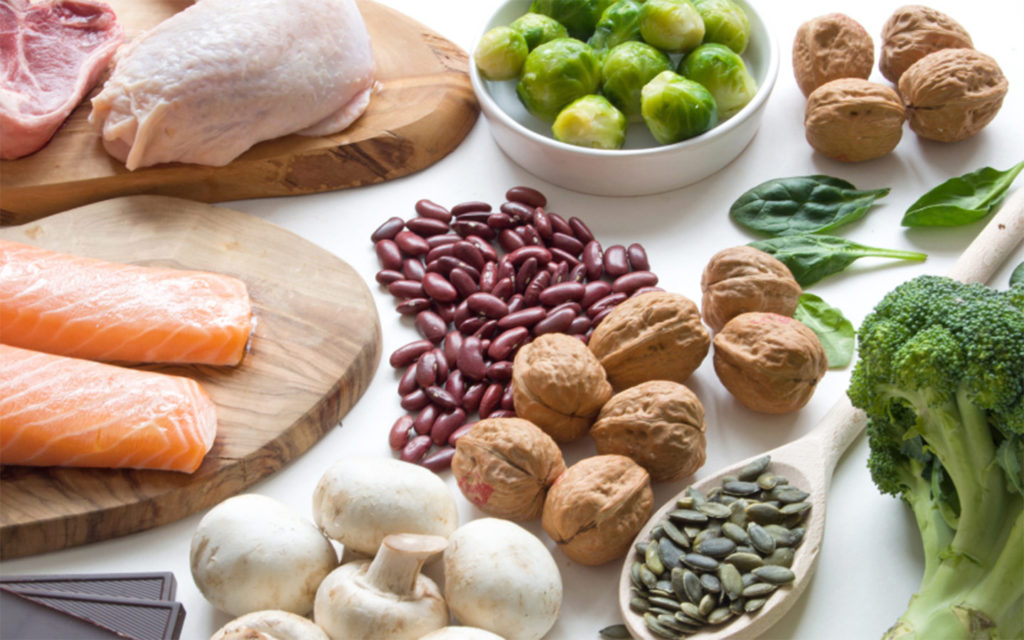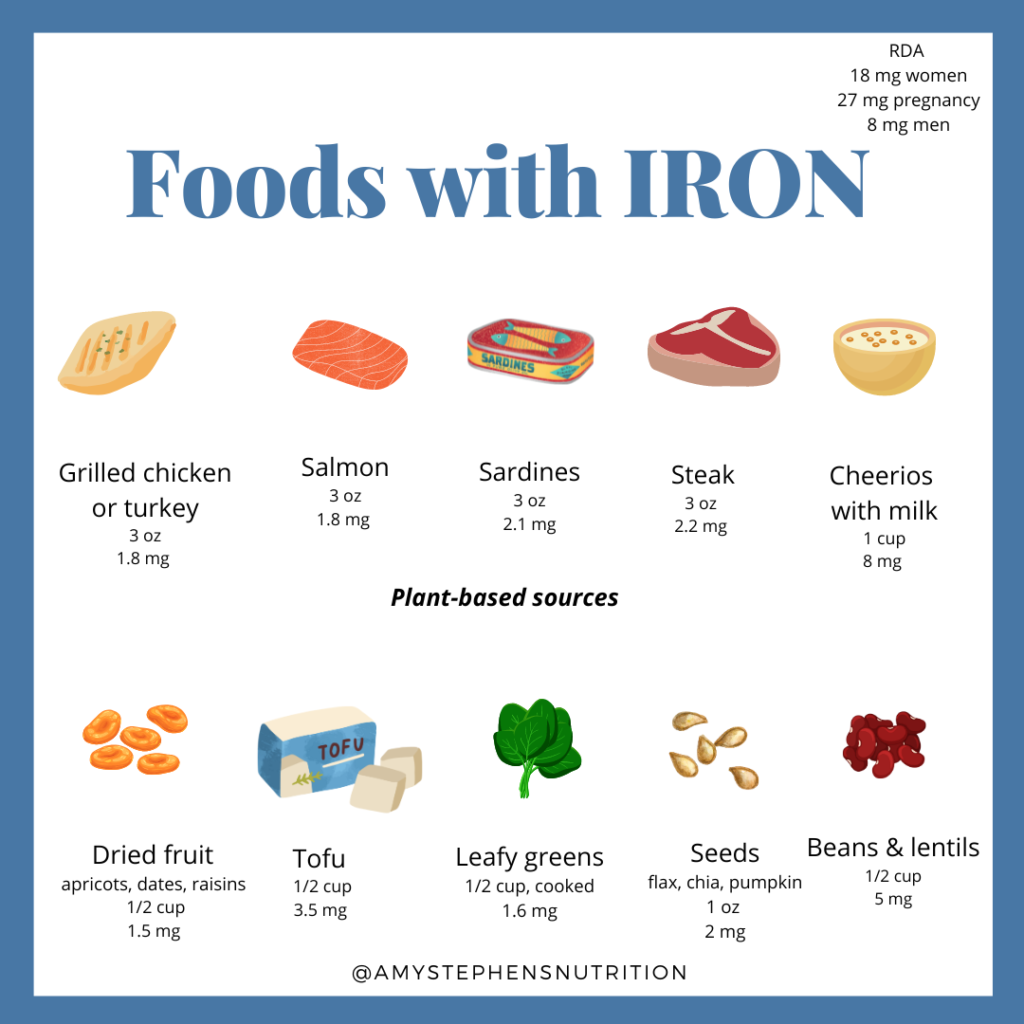Amy Stephens
MS, RDN, CSSD, CEDS
Licensed dietitian
specializing in sports nutrition
and eating disorders
MS, RDN, CSSD, CEDS
Licensed dietitian
specializing in sports nutrition
and eating disorders
Why iron deficiency is important
Iron is essential for endurance athletes because it supports oxygen transport, energy production (ATP), cognitive function (including decision-making), and a healthy immune system. Without adequate iron, the body struggles to deliver oxygen to muscles and produce the energy needed for optimal performance. Our bodies cannot make iron, it must be obtained through the diet.
Low levels of iron mean that fewer red blood cells are available to carry oxygen. Oxygen is essential to power muscles and the removal of metabolic waste so the body can function at peak performance. Many studies have reported the prevalence of iron deficiency in endurance athletes to be as high as 50% in females and 30% in males (Koehler 2012, Tan 2012). Although more common in female athletes, male athletes are also at risk for low iron. Often, athletes will report low energy levels or difficulty completing a workout, and later will find it’s iron deficiency. This post will review how iron impacts performance, symptoms of low iron, and how to prevent iron from impacting performance.

Stages of deficiency
Dr. Peeling defined stages of deficiency and depletion (2007). What’s interesting about these stages is that iron stores can be depleted while hemoglobin levels remain within normal range. It’s not until stages 2 or 3 of deficiency that an athlete begins to see a performance impact. Before a substantial training block begins, assessing individuals’ risk factors and low iron risk factors is helpful. If an athlete has a drop in iron during a racing season, treatment can take a few weeks, which can have a detrimental impact on the racing schedule. A basic iron assessment contains the following labs: ferritin, hemoglobin, and transferrin saturation. Your physician can order these tests and a sports dietitian can help interpret them and review best treatment options.
Think of ferritin like your body’s iron fuel tank. When levels drop below 35 μg/L, it’s like your gas light turning on—your body is running low and needs more iron to function at its best.
> Stage 1—Iron deficiency (ID): iron stores in the bone marrow, liver and spleen are depleted (ferritin < 35 μg/L, Hb > 115 g/L, transferrin saturation > 16%). Treat with food first approach by including many iron-rich foods along with Vitamin C.
> Stage 2—Iron-deficient non-anemia (IDNA): erythro- poiesis diminishes as the iron supply to the erythroid marrow is reduced (ferritin < 20 μg/L, Hb > 115 g/L, transferrin saturation < 16%). Initiate iron supplements 65mg elemental iron. Can take 4-12 weeks to show results.
> Stage 3—Iron-deficient anemia (IDA): Hb production falls, resulting in anemia (ferritin < 12 μg/L, Hb < 115 g/L, transferrin saturation < 16%). When levels are this low, consult with your physician about the cause and best treatment options.
NOTE: 325 mg ferrous sulfate is equivalent to 65 mg elemental iron.
Risk factors for low iron
There are a variety of factors that contribute to low iron levels. Any one of these risk factors can cause iron levels to drop, and multiple risk factors will carry an even greater risk for low iron. Endurance athletes are at the greatest risk due to the hemolysis from the footstrike and blood loss in the gut while running and sweat. During a training block, iron can drop 25-40% (McKay).
Symptoms
Initially, symptoms are not overt, however, you may feel tired overtime or less of a desire to complete a workout. Most common symptoms include: feeling lethargic, dizzy, negative mood, or poor performance (Sim).
Hepcidin
Hepcidin is a hormone released during exercise that inhibits iron absorption for 3-6 hours after a workout (Sim). This hormone regulates the amount of iron absorbed by the gut. Hepcidin levels are known to elevate 3-6 hours after a workout, thus reducing the amount of iron absorbed from food and supplements.
Iron- rich foods
There are two types of iron-rich foods – heme and non heme sources. Heme sources are more bioavailable compared to plant-based iron sources. Up to 35% of heme versus 20% iron from plants are absorbed (Beard). An athlete can add a Vitamin C food to further enhance absorption. If iron stores are very low or you are at a higher risk for iron deficiency, you may require iron supplements in addition to dietary intervention. Currently, the RDI for iron men is 8mg and 18 mg for women.
Heme iron
Non-heme
Click here for a full list of iron-rich foods from the USDA database.

Sample meal ideas
Grilled chicken over rice with roasted red peppers.
Turkey sandwich on whole wheat bread with an orange.
Spinach salad with chickpeas, dried apricots, and lemon vinaigrette dressing.
Key points
Iron is an important nutrient involved with energy production and promoting oxygen uptake. Iron deficiency can negatively impact performance in athletes by reducing oxygen transferred to the cells and making the body work harder to produce energy.
Females, vegetarians, calorie-restricted diets (RED-S), endurance athletes and training at altitude increase the risk for low iron.
Symptoms of iron deficiency include fatigue, negative mood and poor performance.
Hepcidin is a hormone that reduces iron absorption for 3-6 hours following a workout. The best time to take an iron supplement or eat an iron rich meal is outside this window.
Best food sources of iron include meat, fish, poultry, dark green leafy vegetables. Combine iron rich foods with Vitamin C to enhance absorption.
Certain foods will compete with iron absorption, such as calcium and phytates.
Speak with your physician or sports dietitian to help assess and treat iron deficiency.
References
Beard J, Tobin B. 2000. Iron status and exercise. Am J Clin Nutr. 72 (2):594S-597S.
Coates A, Mountjoy M, Burr J. Incidence of iron deficiency and iron deficient anemia in elite runners and triathletes. Clin J Sport Med. 2016.
Koehler K, Braun H, Achtzehn S, Hildebrand U, Predel H-G, Mester J, Schänzer W (2012) Iron status in elite young athletes: gender- dependent influences of diet and exercise. Eur J Appl Physiol 112(2):513–523
McKay, AKA, Peeling P, et al. (2019a) Chronic adherence to a ketogenic diet modifies iron metabolism in elite athletes. Med Science Sports Exercise. 51(3):548-555.
McKay et al. Iron metabolism: interactions with energy and carbohydrate availability. Nutrients. 2020 Nov 30.12(12); 3692
Ostojic SM & Ahmetovic Z. Weekly training volume and hematological status in female top-level athletes. Ahmetovic Journal of Sports Medicine and Physical Fitness; Sep 2008; 48, 3; ProQuest Nursing & Allied Health Source pg. 398
Peeling P, Blee T, Goodman C, Dawson B, Claydon G, Beilby J, Prins A (2007) Effect of iron injections on aerobic-exercise perfor- mance of iron-depleted female athletes. Int J Sport Nutr Exerc Metab 17(3):221–231
Sim et al. Iron considerations for the athlete: a narrative review. Eur J Appl Physiol. 2019 July; 119(7):1463-78
Tan D, Dawson B, Peeling P (2012) Hemolytic effects of a football-specific training session in elite female players. Int J Sports Physiol Perform 7(3):271–276
USDA database for iron rich foods
Licensed Dietitian Specializing in sports nutrition and eating disorders
© Amy Stephens Nutrition
Website by Second Language